The AMD Threadripper 2 CPU Review: The 24-Core 2970WX and 12-Core 2920X Tested
by Ian Cutress on October 29, 2018 9:00 AM ESTGaming: Grand Theft Auto V
The highly anticipated iteration of the Grand Theft Auto franchise hit the shelves on April 14th 2015, with both AMD and NVIDIA in tow to help optimize the title. GTA doesn’t provide graphical presets, but opens up the options to users and extends the boundaries by pushing even the hardest systems to the limit using Rockstar’s Advanced Game Engine under DirectX 11. Whether the user is flying high in the mountains with long draw distances or dealing with assorted trash in the city, when cranked up to maximum it creates stunning visuals but hard work for both the CPU and the GPU.
For our test we have scripted a version of the in-game benchmark. The in-game benchmark consists of five scenarios: four short panning shots with varying lighting and weather effects, and a fifth action sequence that lasts around 90 seconds. We use only the final part of the benchmark, which combines a flight scene in a jet followed by an inner city drive-by through several intersections followed by ramming a tanker that explodes, causing other cars to explode as well. This is a mix of distance rendering followed by a detailed near-rendering action sequence, and the title thankfully spits out frame time data.
| AnandTech CPU Gaming 2019 Game List | ||||||||
| Game | Genre | Release Date | API | IGP | Low | Med | High | |
| Grand Theft Auto V | Open World | Apr 2015 |
DX11 | 720p Low |
1080p High |
1440p Very High |
4K Ultra |
|
There are no presets for the graphics options on GTA, allowing the user to adjust options such as population density and distance scaling on sliders, but others such as texture/shadow/shader/water quality from Low to Very High. Other options include MSAA, soft shadows, post effects, shadow resolution and extended draw distance options. There is a handy option at the top which shows how much video memory the options are expected to consume, with obvious repercussions if a user requests more video memory than is present on the card (although there’s no obvious indication if you have a low end GPU with lots of GPU memory, like an R7 240 4GB).
All of our benchmark results can also be found in our benchmark engine, Bench.
| Game | IGP | Low | Medium | High |
| Average FPS | 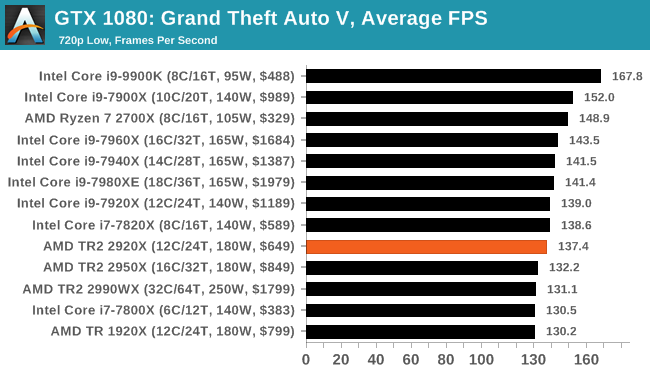 |
 |
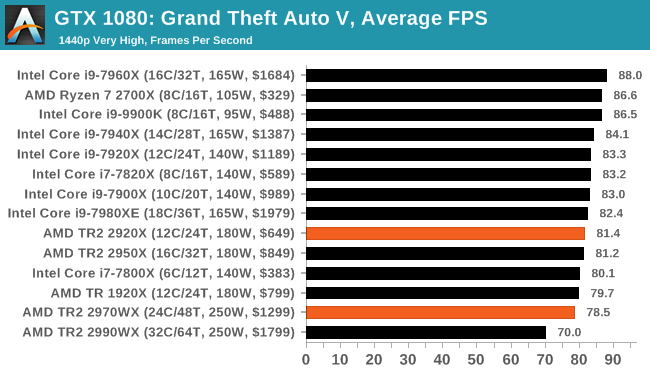 |
 |
| 95th Percentile | 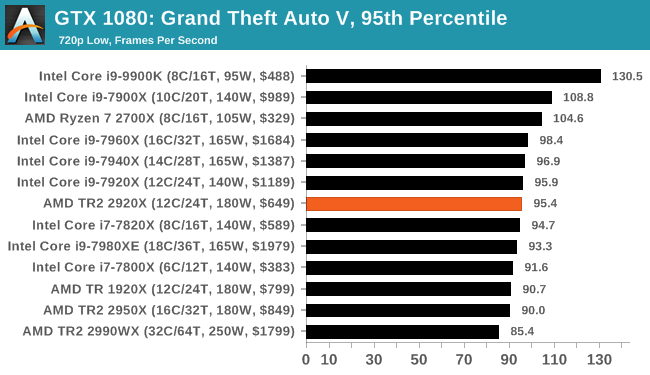 |
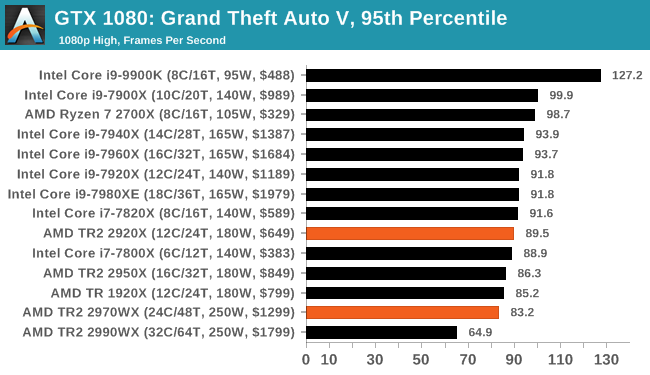 |
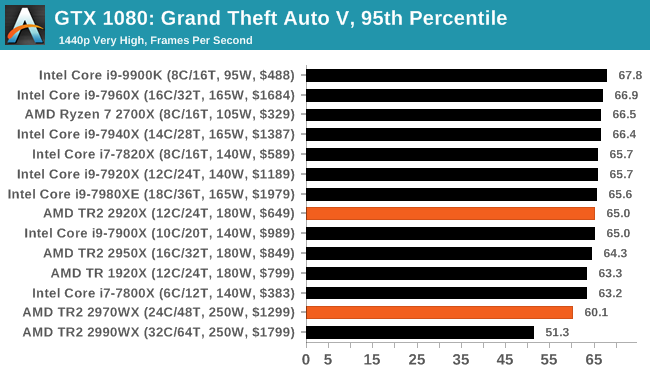 |
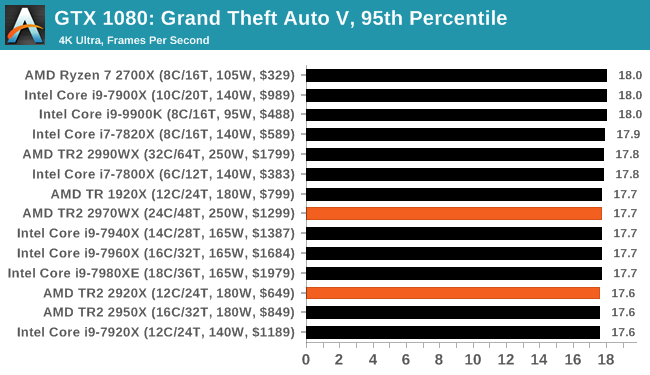 |












69 Comments
View All Comments
The Hardcard - Monday, October 29, 2018 - link
I am not clear on this: can I get a 4-active-die TR for rendering and then turn off the 2 parasite dies when they are a disadvantage. Say make the 2990X operate as a 2950X with the same performance and power?I am not clear if that is what the dynamic local mode is offering. I’d like to be able to do that, whether there is an official AMD path, or if the community finds another way.
BikeDude - Monday, October 29, 2018 - link
<blockquote>Please note, if you plan to share out the Compression graph, please include the Decompression one. Otherwise you’re only presenting half a picture.</blockquote>Many moons ago I made a request to internal IT to adopt 7-zip so that I could save on bandwidth whenever I needed to pull a largish database (this was several years before GDPR obviously).
No go. It turned out that compressing the backups every night eats a lot of time. (decompressing these files was very fast regardless of setup) Well, actually they did use 7z.exe, but only as a normal zipper.
So sometimes the only relevant part of the equation is the compression time. (I do plan on purchasing AMD regardless for my next upgrade)
GreenReaper - Wednesday, October 31, 2018 - link
Use a threading-capable version of xz with the -T parameter so it uses all available threads and you'll find it flies on the default compression settings. It has a Windows version, too: https://tukaani.org/xz/GreenReaper - Wednesday, October 31, 2018 - link
Incidentally, you can probably run it something like xz < "input command" > output.xz, which should mean you don't actually have to write the dumps out, just the compressed version.PaoDeTech - Monday, October 29, 2018 - link
I need 13 cores and 26 threads. Now what? I returned the 32 cores 64 threads one since it could not run FAR CRY at 60fps. But boy could it blend! Sarcasm aside, I write multi-threaded server software and unless I code an infinite loop by mistake (I'm NOT admitting to it) I can never max out 8 threads before hitting I/O limitations (on NVMe PCIe disk). But I can see how some number crunching parallel software would go to town with it.peevee - Wednesday, October 31, 2018 - link
"I can never max out 8 threads before hitting I/O limitations (on NVMe PCIe disk)"Do you know these are IO limitations or do you assume this? Because lack of scaling after 8 threads does not mean IO limit at all. For example, if you write in Java/C#/Python/JS etc (heap-mandatory languages), or even use heap alloc/dealloc in critical thread sections in fast languages like C++, this is what you are going to get (heap mutex = no scalability). And this is just 1 of a thousand pitfalls of massive threading.
PaoDeTech - Thursday, November 1, 2018 - link
No locks, every client call gets its own thread (REST- IIS -WebAPI -.NET "stateless" server - Entity Framework - SQL Server with read committed snapshot isolation). Async all the way down. Under load I can see the disk active >50% and write speed maxes out at 7 MB/s (Toshiba NVMe PCIe 1TB SSD M2). All processes running on the same PC (i7 6700k - 32GB RAM): server, test clients, SQL server. Plenty of free ram.Of course performance optimization is in the details and I was referring to a specific write intensive test case. My point is that parallel scaling is not easy and may stop sooner than expected (for many reasons). On the other hand, I can always use faster single thread performance...
29a - Monday, October 29, 2018 - link
Please replace EgoMark (3DPM) with something else, anything else.danjw - Monday, October 29, 2018 - link
Are there any motherboards out there that support the security features of the Threadripper platform?SLVR - Monday, October 29, 2018 - link
This review is a bit more useful: https://www.techspot.com/review/1737-amd-threadrip...